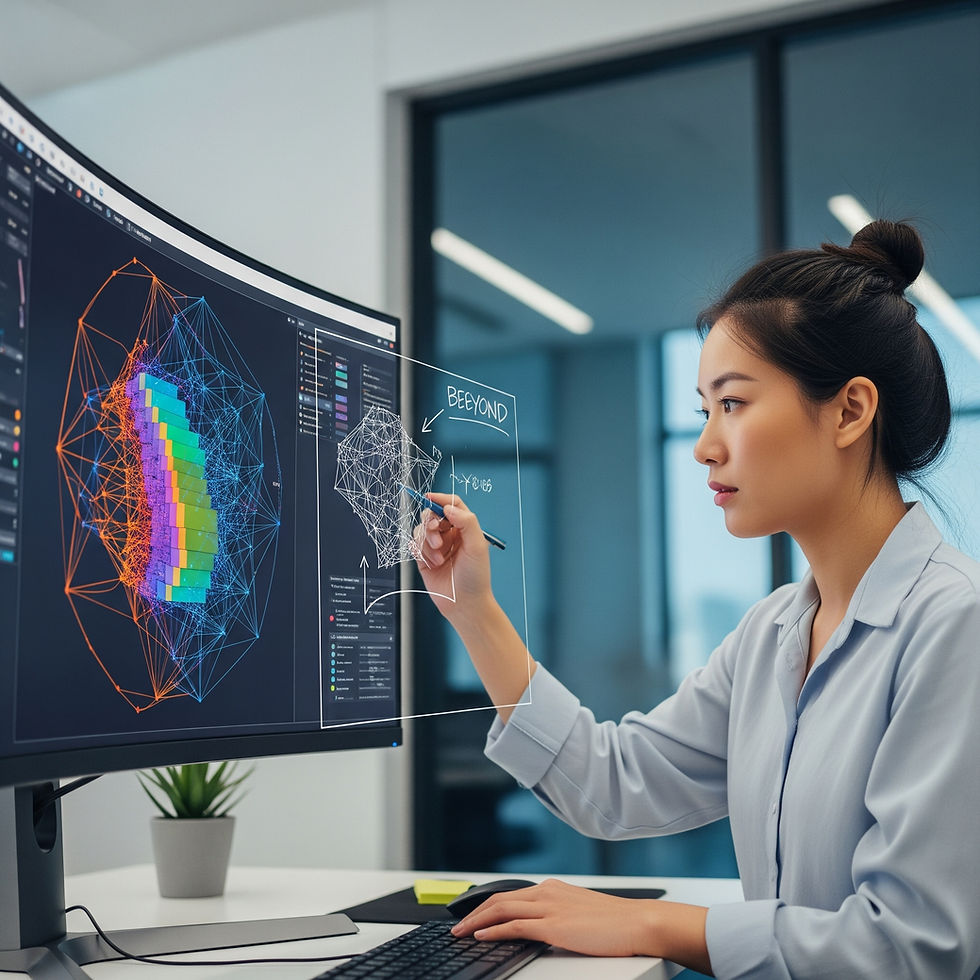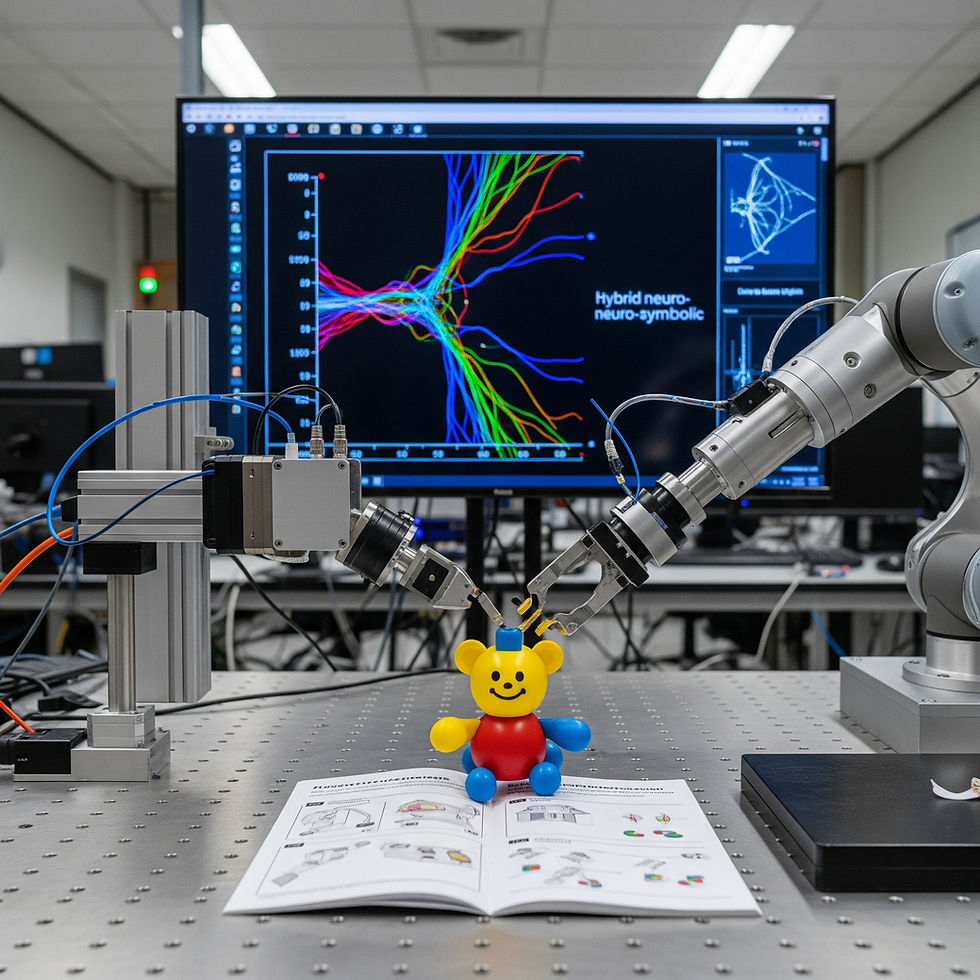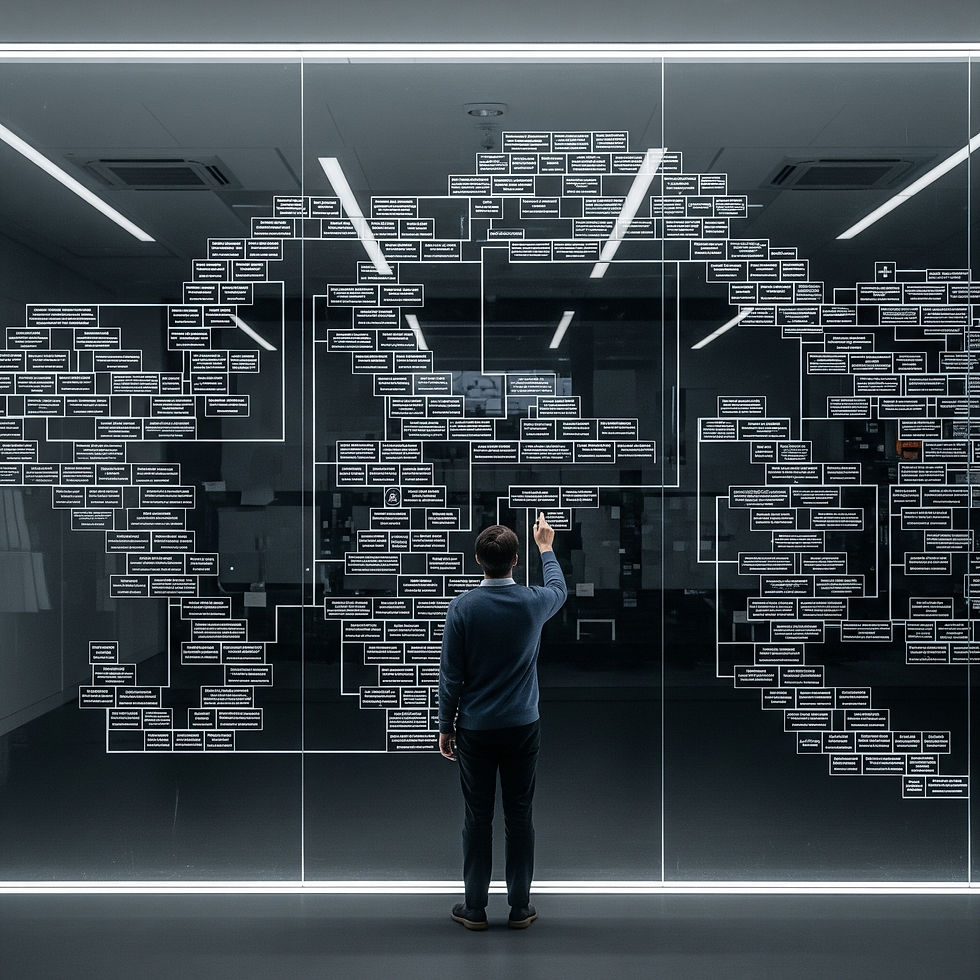Beyond Deep Learning: What Groundbreaking AI Paradigms Will Shape Humanity's Next Chapter?
- Phoenix

- Jun 7
- 6 min read
Updated: Nov 27

🧠 From 'Why' to 'What If': Exploring the Next Wave of Artificial Intelligence
For the past decade, one paradigm has reigned supreme in the world of AI: Deep Learning. This powerful technique, which uses vast neural networks to recognize patterns in data, has given us everything from language models like ChatGPT to image generators and medical diagnostics. But as powerful as deep learning is, it has fundamental limitations. It's a master of correlation but a novice at causation; it requires colossal amounts of data and energy, and it often operates as an unexplainable "black box."
To truly build an AI capable of reasoning, understanding, and collaborating with us to solve the world's most complex problems, we must look beyond deep learning. The next chapter of intelligence is being written in labs exploring entirely new ways for machines to think. The "script that will save humanity" will likely require a more robust, versatile, and trustworthy form of AI—one that can understand not just what is in the data, but why it is, and what if things were different.
This post explores the groundbreaking AI research areas emerging from the shadow of deep learning, from AI that understands cause and effect to systems that combine the best of human-like logic and machine-like pattern matching.
In this post, we explore:
🤔 The limitations of our current deep learning models.
🔗 Causal AI: The quest to teach machines the concept of "why."
🤝 Neuro-Symbolic AI: The powerful hybrid of pattern recognition and logical reasoning.
💧 Liquid Neural Networks & Other Novel Architectures: AI that adapts and evolves in real-time.
✍️ How these new paradigms are essential for building the trustworthy and capable AI of the future.
1. 🤔 The Limits of Looking: Why Deep Learning Isn't Enough
Deep learning models are phenomenal pattern-recognition machines. By training on massive datasets, they can identify statistical correlations with superhuman accuracy. However, this approach has inherent weaknesses that prevent it from achieving true understanding.
Correlation vs. Causation: Deep learning can tell you that two things often happen together, but it can't tell you if one causes the other. It doesn't understand cause and effect, which is the foundation of scientific discovery and common-sense reasoning.
The "Black Box" Problem: We often don't know how a deep learning model arrives at its answers. Its internal logic is hidden within millions of mathematical weights, making it difficult to trust in high-stakes situations like medical diagnosis or legal judgments.
Data & Energy Hungry: These models require enormous datasets and consume vast amounts of computational power for training, raising environmental and accessibility concerns.
Brittleness: They can fail unexpectedly when faced with data that is even slightly different from what they were trained on. They lack the robust, adaptable reasoning of humans.
To build a true partner for humanity, we need an AI that can reason, understand context, and explain its thinking.
🔑 Key Takeaways from Deep Learning's Limits:
Deep learning excels at finding correlations in data but doesn't understand cause and effect.
Its "black box" nature makes it difficult to trust and debug.
It requires massive amounts of data and energy to train.
It lacks the robust, common-sense reasoning needed for true general intelligence.
2. 🔗 Causal AI: Teaching Machines to Ask "Why?"
Imagine an AI that doesn't just predict what will happen, but understands why it happens and can imagine what would happen if things were different. This is the goal of Causal AI.
Building a World Model: Unlike deep learning, which just looks at data, Causal AI attempts to build an internal model of how the world works—a network of causes and effects. It learns the underlying mechanisms that produce the data.
Counterfactual Reasoning: This allows for "what if" questions. A Causal AI could ask: "What would have been the patient's outcome if we had administered a different drug?" This is a level of reasoning that is impossible for standard machine learning but is crucial for science and strategic decision-making.
Robustness and Fairness: By understanding the causal drivers of a system, this type of AI is less likely to be fooled by spurious correlations or biased data. It can make fairer, more reliable decisions because it's based on the "why" rather than just the "what."
The Future of Science: Causal AI could become an incredible tool for scientists, helping them untangle complex systems in biology, economics, and climate science to discover not just what is happening, but the levers we can pull to change the outcome for the better.
🔑 Key Takeaways from Causal AI:
Causal AI focuses on understanding the cause-and-effect relationships within a system.
It enables powerful "what if" (counterfactual) reasoning, which is critical for science and strategy.
By understanding "why," it can make more robust, fair, and trustworthy decisions.
This paradigm is essential for moving AI from a pattern-recognizer to a genuine scientific partner.
3. 🤝 Neuro-Symbolic AI: The Best of Both Worlds
Human intelligence seems to have two modes of thinking: a fast, intuitive, pattern-matching mode (like recognizing a face) and a slow, deliberate, logical mode (like solving a math problem). Deep learning mimics the first, while classical, Symbolic AI (rule-based systems) mimics the second. Neuro-Symbolic AI aims to combine them.
The Hybrid Brain: This approach integrates deep learning's neural networks with the explicit rules and symbols of classical AI. The neural network handles the messy, real-world data (like images or sounds), and the symbolic part handles the abstract reasoning, logic, and knowledge representation.
Example in Action: Imagine an AI analyzing a street scene. The neural part recognizes the objects: "car," "pedestrian," "traffic light." The symbolic part uses pre-programmed rules like "a red traffic light means cars must stop" and "pedestrians have the right of way at a crosswalk" to reason about the situation and predict what should happen next.
Explainability and Knowledge: This hybrid model is far more transparent than pure deep learning. If it makes a decision, it can point to the specific logical rule it used. It can also easily incorporate new knowledge without having to be completely retrained.
🔑 Key Takeaways from Neuro-Symbolic AI:
It combines the pattern-recognition strengths of neural networks with the logical reasoning of symbolic AI.
This hybrid approach allows AI to handle both messy data and abstract rules.
Neuro-Symbolic systems are more explainable and trustworthy than "black box" deep learning models.
This paradigm is a promising path toward AI that has both intuition and common-sense reasoning.

✨ Weaving a New Intelligence: The Path Forward
The future of AI will not be built on a single monolithic paradigm. The "script that will save humanity" will be powered by a tapestry of different approaches, woven together to create a more robust, adaptable, and trustworthy form of intelligence.
Deep learning laid the foundation, proving that machines could learn from data at a massive scale. Now, the next wave of innovation—Causal AI that understands why, Neuro-Symbolic
AI that reasons with logic, and other novel architectures that learn efficiently—will build upon that foundation. These emerging paradigms will give us AI systems that are not just powerful prediction engines, but true partners in our quest for knowledge and progress. By moving beyond the limits of today's technology, we can build the AI we truly need: one that is capable, cooperative, and aligned with our highest aspirations.
💬 Join the Conversation:
Which of these emerging AI paradigms do you find the most exciting?
What is the biggest challenge you think AI needs to overcome to become a true partner for humanity?
Do you believe combining different AI approaches is the key to achieving AGI?
What is one real-world problem you would love to see solved by a more advanced, causal, or neuro-symbolic AI?
We invite you to share your thoughts in the comments below! Thank you.
📖 Glossary of Key Terms
🧠 Deep Learning: A subfield of machine learning based on artificial neural networks with many layers, currently the dominant paradigm in AI.
🔗 Causal AI: An area of AI research focused on understanding cause-and-effect relationships, enabling counterfactual or "what if" reasoning.
🤝 Neuro-Symbolic AI: A hybrid approach that integrates connectionist (neural networks) and symbolic (rules-based) AI architectures.
🤔 Symbolic AI: The classical approach to AI (dominant from the 1950s-1980s) based on manipulating symbols and rules of logic.
⚫ Black Box: A term for a complex system, like a deep neural network, where the internal workings are not visible or understandable to its users.
❓ Counterfactual Reasoning: The ability to consider possible alternatives to past events; thinking about "what if" scenarios.
💧 Liquid Neural Networks: A type of time-varying neural network whose parameters can change over time, allowing it to adapt to new inputs continuously.
🤖 AGI (Artificial General Intelligence): A hypothetical form of AI with the ability to understand, learn, and apply knowledge across a wide range of tasks at a human or superhuman level.

Posts on the topic ⚛️ AI's Future Frontiers:
Artificial General Intelligence (AGI): Humanity's Greatest Challenge or Ultimate Salvation Tool?
The AI Consciousness Conundrum: If Machines Wake Up, What Does It Mean for Our Future?
AI & Conscience: Navigating the Ethical Labyrinth
Quantum AI & Neuromorphic Chips: The Next Hardware Frontiers
AI and Existential Hope: Can Advanced Intelligence Help Us Avert Global Catastrophic Risks?
Beyond Deep Learning: What Groundbreaking AI Paradigms Will Shape Humanity's Next Chapter?
The Future of Human-AI Symbiosis: Co-evolving for a Flourishing Planetary Future
Digital Immortality & AI: Uploading Consciousness or a False Promise for Humanity's Future?
AI Safety & Global Catastrophic Risk Mitigation: Building the Guardrails Before We Build the Gods
The "Singularity" and Beyond: How AI Could Redefine "Humanity" in the Script to Save Itself




Comments